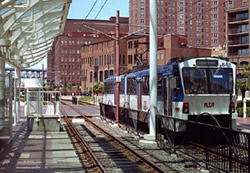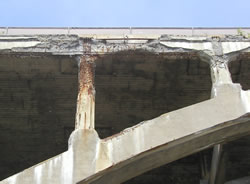 |

Encouraging mixed-use development in proximity to transit service can strengthen the competitiveness of urban neighborhoods. [RTA Waterfront Line station] | TRANSPORTATION & INFRASTRUCTURE
GOAL: Provide a variety of transportation options that serve residents of all income levels and that promote economic development while protecting the quality of life in neighborhoods
Issues
Cleveland is located at a nexus of the regional and national transportation network, where freeway, rail, airline and shipping routes converge. This extraordinary transportation access was largely responsible for Cleveland’s growth as a national center of economic activity.
On the local level, within the City itself, the rail lines branch off to serve local industry and the freeway system provides access to a system of roads that serve businesses and residents alike. Commuter rail lines complete the local transportation network, along with sidewalks for pedestrians and routes for bicyclists. Among the transportation issues facing Cleveland are the following.
- an aging network of roads and bridges in need of repair and replacement
- inadequate freeway access to industries, forcing truck traffic onto residential streets
- an automobile-dominated region that reduces use of public transit and leaves many transit-dependent individuals under-served
- insufficient opportunities for safe and convenient bicycle travel
- unfulfilled potential to create transit-oriented development districts
- the need for shipping to be balanced with needs for waterfront recreation
- maintaining Cleveland’s long-term viability for national and international air travel
|
|

The Citywide Plan advocates placing priority on the upgrading of existing infrastructure in the allocation of transportation and infrastructure funding. [Fulton Road Bridge over Big Creek valley] |
Policies
- Transit-Oriented Development. Target high-density development in proximity to transit stations and major bus stops in order to support public transit and strengthen the competitiveness of urban neighborhoods.
- Mixed-Use Development. Encourage mixed-use development that reduces dependence on motorized vehicles to reach employment and shopping destinations.
- Mass Transit. Support improved bus and rapid transit service, through public funding and employer incentives, to serve individuals who require or prefer mass transit and to reduce the pollution and roadway congestion caused by use of personal automobiles.
- Neighborhood Bus Service. Continue and expand RTA’s “Community Circulator” program, providing convenient bus service to residents using mass transit to reach such neighborhood destinations as shopping, recreation and medical services.
- Transit Amenities. Upgrade the condition of bus shelters, transit stations, and transit vehicles, and provide improved information on schedules and routes.
- Transit Line Extensions. Consider strategic extensions to existing mass transit lines where significant ridership increases are likely.
- Bicycle Travel. Develop a citywide and regional network of safe bicycle routes, connecting to work, school, shopping and recreation destinations; and make bicycle accommodation a routine component of roadway and development projects.
- Pedestrian Travel. Make Cleveland a national model for pedestrian-friendly neighborhoods, featuring conveniently-located sidewalks and paths, benches, and streetside development patterns.
- Maintenance of Existing Infrastructure. Work with regional, state and federal agencies to give priority to the maintenance of existing transportation infrastructure in the allocation of transportation funding.
- Ports. Ensure Cleveland’s long-term viability as a hub for air- and water-based transportation, while reserving appropriately located land for waterfront recreation.
- Regional Land Use Planning. Coordinate transportation and infrastructure planning with land use plans designed to limit the negative impacts of urban sprawl and promote more efficient use of existing infrastructure and community facilities.
- Industrial Access. Develop roads that provide direct truck access between freeways and industrial areas, by-passing neighborhoods where truck traffic degrades the quality of life for residents.
- Job Access. Provide transit service between central city neighborhoods and employment concentrations in the city and in outlying areas.
- Traffic Calming. Institute “traffic-calming” measures in residential areas and neighborhood shopping districts where existing traffic volumes and speeds create safety hazards and unpleasant conditions for residents and shoppers.
|
Continue to the Next Section: Goals & Policies: Arts and Culture |
 |





